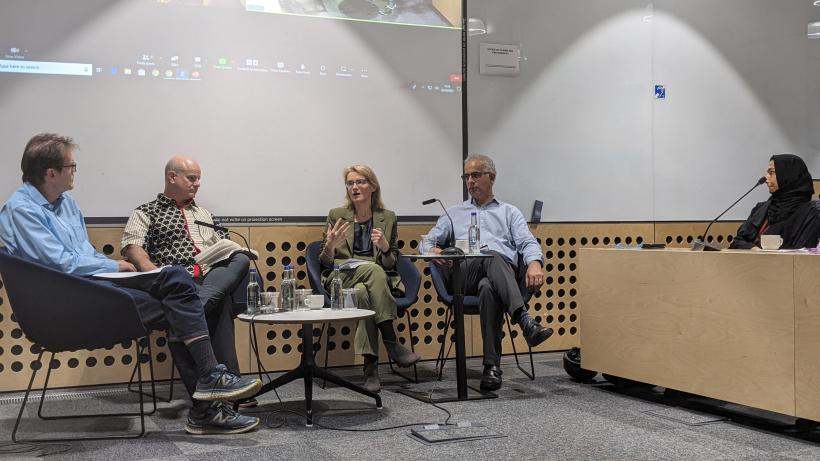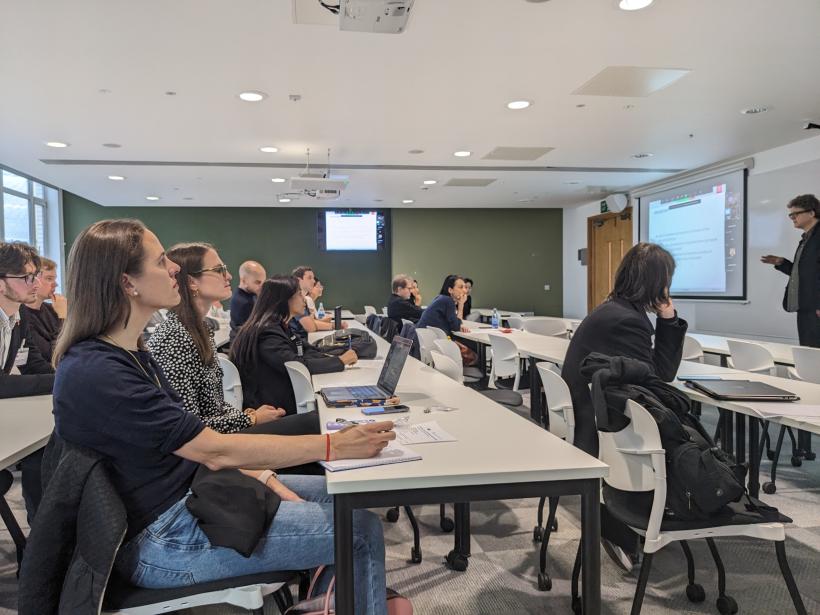
Insights from the 2023 Firms, Trade, and Development Conference
The IGC collaborated with the Yale Economic Growth Center to organise the 2023 Firms, Trade, and Development conference that brought together academics and policymakers to delve into the latest research on firms, markets, trade, and institutions in low- and middle-income countries.
How do interactions between markets and firms affect economic growth? Do policymakers face trade-offs in pursuing sustainable growth in underdeveloped markets? Are there empirically grounded strategies for resolving market frictions in these nations?
These questions formed the focus of this year's Firms, Trade, and Development Conference. The event was a collaboration between the International Growth Centre and the Economics Growth Center (EGC) at Yale. Members of the organising committee included Penny Goldberg, Amit Khandelwal, Lauren Falcao Bergquist, Mayara Felix, David Atkin, Namrata Kala, Isabela Manelici, Meredith Startz, Eric Verhoogen, and Chris Woodruff.
In an IGC blog, Rahul Shukla and Sagar Saxena delved into present scholarship to begin to answer these questions. A common thread in the literature is that policymakers in low- and middle-income countries face the challenge of solving market and trade frictions, while at the same time having to chart growth paths that are environmentally sustainable.
On 19 and 20 October 2023, speakers and members of the global community working on firms, markets, trade, institutions, and development in low- and middle-income countries converged on Yale's and the London School of Economics’ respective campuses to engage with these questions over two days. Presentations occurred jointly at LSE and Yale and were live-streamed so participants at both locations could tune in and field questions. Over 149 participants from 38 countries joined virtually, with 52 in-person participants at EGC and 29 at IGC.
Understanding the market forces that accelerate growth in LMICs
Presentations on Day 1 centred on understanding how market dynamics affect growth in LMICs—from understanding how state capacity in resolving disputes affects credit access, to how market-wide employment opportunities for women workers affect their bargaining power within firms, to firm-level incentives to adapt new, productive technologies.
The theme of the presentations for Day 1 culminated in emphasising how markets and firms contribute to economic development in the context of LMICs, which have historically received little attention compared with their wealthier counterparts.

Robin Burgess presenting his keynote at LSE (Image via IGC).
Robin Burgess delivered the keynote presentation for this year’s conference. He presented new descriptive evidence linking economic growth to the variety of jobs available in a country. The nature of evidence was both across countries and within countries. In particular, he showed that in lower-income settings, a small number of job "titles" employ a majority of the workforce, while in higher-income settings, employment is spread out over a much larger range of job titles. He also showed that the number of job titles is positively associated with the prevalence of salaried/paid work and the presence of larger firms.
Other presentations focused on the origins of market frictions. Manaswini Rao, for instance, explored how court backlogs in India limit economic growth by freezing investable assets in litigation. Resulting inefficiencies in resource allocation can be mitigated by increasing the Indian judiciary’s capacity to resolve disputes quickly. Rao concludes that investment in India’s judicial capacities can provide tax revenue and economic gains six and 30 times higher, respectively, than the cost of hiring an additional judge.
Philipp Barteska continued on the topic of state capacity by exploring how “good” bureaucrats helped realise the objectives of South Korean export policies. Using data from the late 1960s to the early 2000s, Barteska found heterogeneous effects of bureaucratic office expansions affected exports. A critical insight is that placing the “good” bureaucrats in key positions matters for economic growth and industrial policy. Moving up bureaucrat ability from the 20th percentile to the 50th percentile increases exports by about 40%.
Tristan Reed presented work exploring the returns to private equity investments in developing countries over a 70-year period. Specifically, Reed studies the complete global portfolio of equity investments made by the International Finance Corporation (IFC) since its founding in 1956 and finds that returns to private equity in developing countries are comparable to or higher than benchmarks like the S&P 500. The results also suggest that barriers and information costs restrict capital flows to developing countries, lending support to the "Lucas puzzle."
Garima Sharma traced the origins of the gender gap in wages in LMICs by investigating Brazil’s textile manufacturing sector. Sharma finds that the firms that provide benefits and amenities for women, such as maternity leave and flexibility in childcare, can pay women lower wages than men while retaining women employees. Giving women sufficient employment options to minimise this monopsony power of firms can allow them to earn a wage proportionate to their productivity.
Finally, Martin Rotemberg shared insights on the delayed acceptance of steam power in 19th-century manufacturing, a perplexing development since technological innovations typically encourage economic growth. Rotemberg finds that path dependence at the firm level contributes to the adoption of new technologies. This insight might apply to LMICs by suggesting that limited access to vital natural resources reduces the capacity for market entry.
The theme of the presentations for Day 1 culminated in emphasising how markets and firms contribute to economic development in the context of LMICs, which have historically received little attention compared with their wealthier counterparts
The causes of and policy responses to resource misallocation in LMICs
Presentations on Day 2 expanded on themes from Day 1, focusing on the experience of firms in LMICs. Most presentations pinpointed the welfare effects of resource misallocation caused by market distortions.

The policy panel featuring (left to right) Chris Woodruff, Dean Karlan, Liz Lloyd, and Adnan Khan at the LSE (Image via IGC).
Dave Donaldson assessed the costs of production misallocations from market distortions, such as corruption and incomplete contracts, for firms in LMICs. Donaldson discussed how identifying misallocation from data without strong functional form assumptions is usually difficult and presented a new framework to infer the efficiency of market allocations under weaker assumptions. He implements the framework using data from procurement lotteries in Ecuador that provide quasi-experimental variation (i.e., who wins is exogenous) to determine the extent of misallocation in the construction sector. The findings suggest that the total cost of misallocation in this sector is just 1.6% – considerably smaller than typical existing estimates.
Jeremy Majerovitz presented a very related paper that also developed a new approach to measure the cost of misallocation in a market under weaker assumptions than earlier papers. This methodology is based on the clever insight that the cost of misallocation can be expressed as a function of the variance of the log marginal revenue product of capital (MRPK) across firms, i.e. the revenue generated by introducing one additional unit of resources to the firm. Majerovitz estimates this variance using data from a randomised controlled trial (RCT) that gave capital grants to microenterprises in Sri Lanka, and finds that optimally reallocating all inputs would increase output substantially.
Following Majerovitz’s presentation, a group of policymakers convened for a “Policymaker Panel Session on Fostering Growth in Developing Countries”, presented at LSE and virtually. The discussion focused on sustainable growth amidst climate change, financial inclusion, and gender equity.
Adnan Khan opened the discussion by observing that most policymakers and researchers look at economic growth in LMICs negatively but must recognise that it is necessary to fulfill the goals of financial equity. “Don’t put zero weight on growth…even in order to achieve the other objective of inclusion, we need to have growth.”
Dean Karlan countered and expanded on Khan’s insights by explaining that most growth does not have the intent for inclusion.“Growth is great, but think about the type of growth we are going to be experiencing…our productivity for labour is going way up with technology…we can do something about growth’s inclusivity [but] at the investment level, there’s not much attention on the intentionality issue.”
Liz Lloyd discussed the efforts of the British International Investment towards financial inclusion, both generally for LMICs and for specific groups, such as women.“We want more economic opportunities for women, and we’re trying to do research right now about understanding the relationship between senior leadership and firm behaviour.”
Godfrey Kamutando went one step further by asking whether misallocation is a concern in informal sectors, an understudied sector in the allocation economics literature. Using Zimbabwe as an empirical case study, where the informal sector accounts for 61% of GDP, Kamutando finds that failing to account for informal firms can bias estimates of resource misallocation.
Rikhia Bhukta asked whether financial inclusion reduces welfare disparities resulting from caste-based social exclusion. Bhukta found that though Indian castes are less rigid than ever, caste-based wage discrimination and differential access to credit remain steep obstacles for individuals of lower castes. She provides a promising solution: bank expansion policies, which enhance access to formal financial services across all caste categories and promote financial inclusion.
Miguel Angel Talamas Marcos conducted a neighbourhood-level analysis to explain how microenterprises respond to competition to convenience chain store entry. Focusing on Mexico, Marcos found that the arrival of chain stores in Mexican neighbourhoods reduced the entry of tienditas, or small, local Mexican shops. The remaining tienditas adapted by offering greater product variety. They also survived because of the comparative advantages of local ownership and small size, a relevant insight for LMICs' contexts as these tienditas were cash and credit-constrained.
Isabela Manelici presented a framework to quantify the welfare effects of foreign multinational enterprises (MNEs) operating in an economy with distortions, using Mexico as a case study. The paper presented evidence of extensive heterogeneity in distortions (for example, taxes, regulations, crime) across different types of establishments and locations in Mexico. Manelici found that increased foreign MNE employment in a location benefits the local formal sector but leaves the informal sector largely unaffected. Specifically, more foreign MNEs are associated with more domestic formal sector establishments, workers, sales, among others.
Interdisciplinary insights and the path to inclusive growth
The 2023 Firms, Trade, and Development Conference has occurred annually for 14 years. Now a hub for the international development economics community, it provides pertinent insights that can help shape academics’ and policymakers’ understandings of economic development in LMICs.
A version of this article was first published by the Yale Economic Growth Center. You can watch the recordings of the IGC-EGC Conference on Firms, Trade, and Development.

